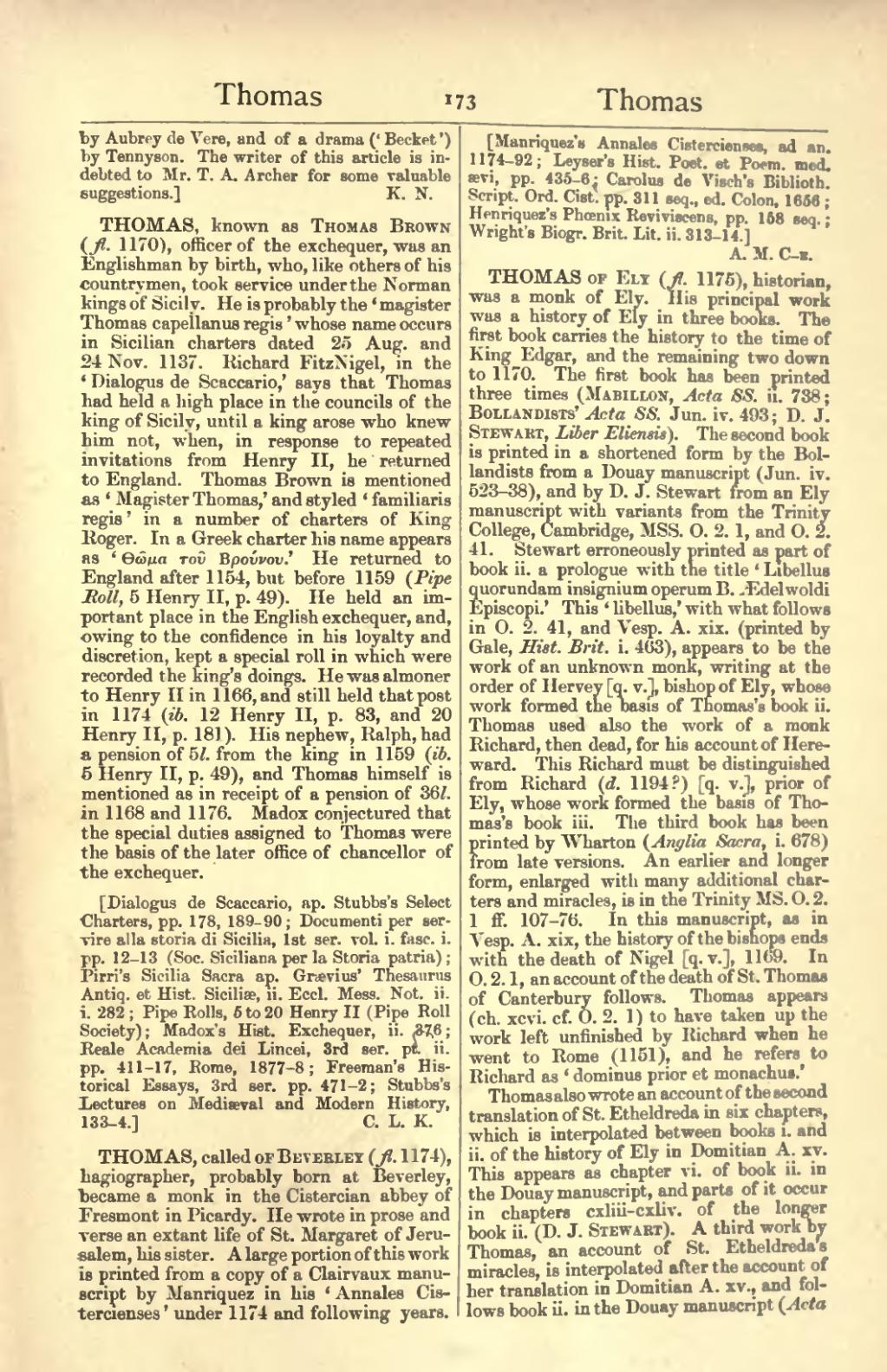by Aubrey de Vere, and of a drama (‘Becket’) by Tennyson. The writer of this article is indebted to Mr. T. A. Archer for some valuable suggestions.]
THOMAS, known as Thomas Brown (fl. 1170), officer of the exchequer, was an Englishman by birth, who, like others of his countrymen, took service under the Norman kings of Sicily. He is probably the ‘magister Thomas capellanus regis’ whose name occurs in Sicilian charters dated 25 Aug. and 24 Nov. 1137. Richard FitzNigel, in the ‘Dialogus de Scaccario,’ says that Thomas had held a high place in the councils of the king of Sicily, until a king arose who knew him not, when, in response to repeated invitations from Henry II, he returned to England. Thomas Brown is mentioned as ‘Magister Thomas,’ and styled ‘familiaris regis’ in a number of charters of King Roger. In a Greek charter his name appears as ‘Θῶμα τοῦ Βρούνου.’ He returned to England after 1154, but before 1159 (Pipe Roll, 5 Henry II, p. 49). He held an important place in the English exchequer, and, owing to the confidence in his loyalty and discretion, kept a special roll in which were recorded the king's doings. He was almoner to Henry II in 1166, and still held that post in 1174 (ib. 12 Henry II, p. 83, and 20 Henry II, p. 181). His nephew, Ralph, had a pension of 5l. from the king in 1159 (ib. 5 Henry II, p. 49), and Thomas himself is mentioned as in receipt of a pension of 36l. in 1168 and 1176. Madox conjectured that the special duties assigned to Thomas were the basis of the later office of chancellor of the exchequer.
[Dialogus de Scaccario, ap. Stubbs's Select Charters, pp. 178, 189–90; Documenti per servire alla storia di Sicilia, 1st ser. vol. i. fasc. i. pp. 12–13 (Soc. Siciliana per la Storia patria); Pirri's Sicilia Sacra ap. Grævius' Thesaurus Antiq. et Hist. Siciliæ, ii. Eccl. Mess. Not. ii. i. 282; Pipe Rolls, 5 to 20 Henry II (Pipe Roll Society); Madox's Hist. Exchequer, ii. 376; Reale Academia dei Lincei, 3rd ser. pt. ii. pp. 411–17, Rome, 1877–8; Freeman's Historical Essays, 3rd ser. pp. 471–2; Stubbs's Lectures on Mediæval and Modern History, 133–4.]
THOMAS, called of Beverley (fl. 1174), hagiographer, probably born at Beverley, became a monk in the Cistercian abbey of Fresmont in Picardy. He wrote in prose and verse an extant life of St. Margaret of Jerusalem, his sister. A large portion of this work is printed from a copy of a Clairvaux manuscript by Manriquez in his ‘Annales Cistercienses’ under 1174 and following years.
[Manriquez's Annales Cistercienses, ad an. 1174–92; Leyser's Hist. Poet. et Poem. med. ævi, pp. 435–6; Carolus de Visch's Biblioth. Script. Ord. Cist. pp. 311 seq., ed. Colon, 1656; Henriquez's Phœnix Reviviscens, pp. 158 seq.; Wright's Biogr. Brit. Lit. ii. 313–14.]
THOMAS of Ely (fl. 1175), historian, was a monk of Ely. His principal work was a history of Ely in three books. The first book carries the history to the time of King Edgar, and the remaining two down to 1170. The first book has been printed three times (Mabillon, Acta SS. ii. 738; Bollandists' Acta SS. Jun. iv. 493; D. J. Stewart, Liber Eliensis). The second book is printed in a shortened form by the Bollandists from a Douay manuscript (Jun. iv. 523–38), and by D. J. Stewart from an Ely manuscript with variants from the Trinity College, Cambridge, MSS. O. 2. 1, and O. 2. 41. Stewart erroneously printed as part of book ii. a prologue with the title ‘Libellus quorundam insignium operum B. Ædelwoldi Episcopi.’ This ‘libellus,’ with what follows in O. 2. 41, and Vesp. A. xix. (printed by Gale, Hist. Brit. i. 463), appears to be the work of an unknown monk, writing at the order of Hervey [q. v.], bishop of Ely, whose work formed the basis of Thomas's book ii. Thomas used also the work of a monk Richard, then dead, for his account of Hereward. This Richard must be distinguished from Richard (d. 1194?) [q. v.], prior of Ely, whose work formed the basis of Thomas's book iii. The third book has been printed by Wharton (Anglia Sacra, i. 678) from late versions. An earlier and longer form, enlarged with many additional charters and miracles, is in the Trinity MS. O. 2. 1 ff. 107–76. In this manuscript, as in Vesp. A. xix, the history of the bishops ends with the death of Nigel [q. v.], 1169. In O. 2. 1, an account of the death of St. Thomas of Canterbury follows. Thomas appears (ch. xcvi. cf. O. 2. 1) to have taken up the work left unfinished by Richard when he went to Rome (1151), and he refers to Richard as ‘dominus prior et monachus.’
Thomas also wrote an account of the second translation of St. Etheldreda in six chapters, which is interpolated between books i. and ii. of the history of Ely in Domitian A. xv. This appears as chapter vi. of book ii. in the Douay manuscript, and parts of it occur in chapters cxliii–cxliv. of the longer book ii. (D. J. Stewart). A third work by Thomas, an account of St. Etheldreda's miracles, is interpolated after the account of her translation in Domitian A. xv., and follows book ii. in the Douay manuscript (Acta
